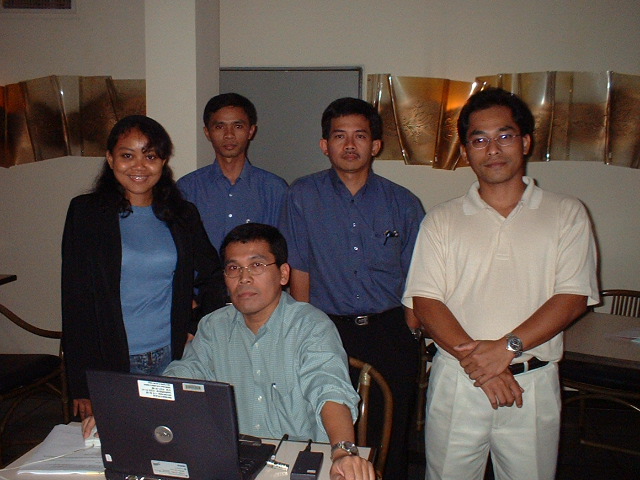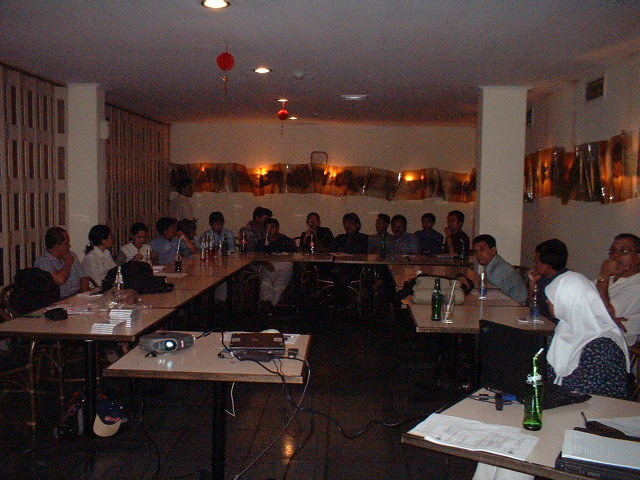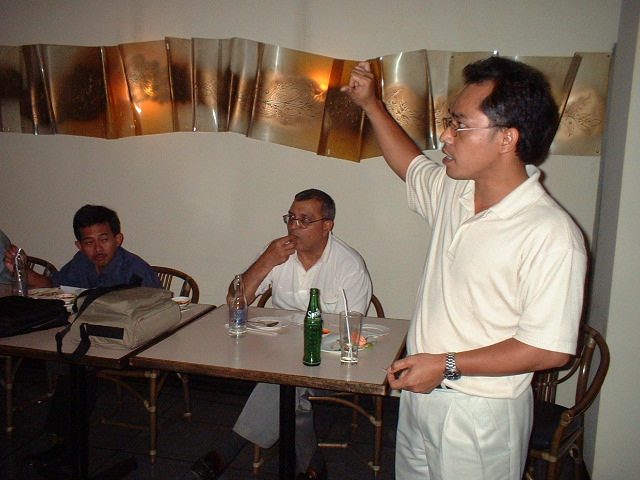IS IT A PAY OR IS IT NOT?
Report on FOSI Open Discussion on Low Resistivity Pay
(as published in Berita IAGI No. 08.37 February 2003)
by Nila Murti
After a long absence, FOSI’s (Forum Sedimentologiwan Indonesia / Indonesian Sedimentologists Forum) Open Discussion is back on air again. For its first performance this year, the Open Discussion took the topic of Low Resistivity – Low Contrast Pay to accommodate a growing interest in this particular petrophysics problem. Low resistivity pay problem aparently is a common one in Indonesia, since many of our reservoirs are shaly in nature, therefore many petrophysicists and geologists from different companies in Indonesia are faced with it, as shown in several email discussions held in IAGI net miling list. The Open Discussion forum was held on Friday evening of 7 February 2003 in Tamnak Thai restaurant in Jalan H.O.S. Cokroaminoto, Menteng, Jakarta, and was attended by 24 participants from various oil and service companies, including by IAGI chairman Andang Bachtiar. Although the interest in attending the discussion was quite high, we had to limit the number of participants to make the discussion more effective. This unfortunately caused some disappointment as some people who did not register early enough had to be placed on a waiting list and in the end could not attend the discussion.
The discussion was opened at 5 pm by FOSI’s General Secretary Hasan Sidi, who welcomed the participants and encouraged them to have a lively discussion. It was continued by a presentation from Sanggam Hutabarat (Schlumberger) who excellently summarised the knowledge we have so far about Low Resistivity/Low Contrast Pay: what it is, what causes it, where we can find the same problem and how we should deal with it. In summary, there are several definitions of Low Contrast Pay, but the most general one stated that it is ‘…a lack of resistivity contrast between sands and the adjacent shales.’ It therefore includes a real low resistivity type of pay with a Deep Induction value of less than 2 ohmm, a low contrast one with a resistivity value of less than 150% of the shale base line, and thin bed pay with less than 6 inches of bed thickness. As the above types indicate, the low contrast-low resistivity pay zone can be caused by thin interbedding of sand and shale or shaly sands, by very fresh or very low-salinity formation water, or by the rock’s mineral content which causes it to be conductive, such as clay minerals or other conductive minerals like pyrite and glauconite. According to Sanggam, the way to approach Low Resistivity problem is to use as many different types of data as possible, from mud logs to wireline logs and wireline tester, also from laboratory tests and sedimentological and facies analysis. New wireline resistivity tools with high vertical resolution and deeper readings, image tools and magnetic resonance tools will also contribute better information to solve the LRP problem, although these data will have to be integrated with the more conventional ones to give a better understanding of the nature of the problem. His presentation was concluded with a quick question-and-answer session.
Ika Kartika Dewi from BP took the forum next, presenting a Low Resistivity Pay problem they encountered in some fields in their Offshore North West Java block. BP petrophysicists dealt with the problem in two ways: for the older wells they used RWa techniques – comparing RWa’s in different levels of intervals which has low resistivity and yet has proven to be pay zones, and for the newer wells they added to the database data from various sophisticated logging tools like CMR, MRIL, and imaging tools, and analysed them comprehensively to find an understanding of the nature of the low resistivity pay zone. The presentation was followed by a lively discussion moderated by Shofiyuddin from ConocoPhillips. Questions and discussions ranged from the RWa technique they used to what kind of data we can use to decide testing a (suspected) low resistivity pay in a wildcat well. Many participants agreed that in the last case, gas reading from the mudlogging tool is proved to be a reliable data to help decide testing.
Baker Atlas Costumer Service Manager Prio Sambodo, who had kindly sponsored the event by providing the venue and the refreshment, then presented the new Baker Atlas tool called 3D Explorer, which is basically an Induction tool which not only measures formation conductivity horizontally but also vertically. This multicomponent induction instrument is expected to be able to identify low resistivity zones which are caused by finely laminated sand and shale intervals, by showing a different horizontal and vertical formation resistivity in a zone with high anisotropy.
Finally, while enjoying the refreshments, Umi Kurniyati from Vico briefly showed her project, identifying low resistivity pay zone through analysis of gas composition read by mudlogging tools during drilling. This could potentially become one of the candidates for our next discussion or evening talk topics. Further discussion points noted by the moderator include how much the water cut from the LRP zone will be, to which a participant suggested to use NMR technology to define the irreducible and free water saturation. NMR logs can also help in choosing the effective porosity, however this has to be supported by laboratory work on cores to help choosing the T2 cutoffs. Nearing the end of the event IAGI chairman Andang Bachtiar threw out ideas and discussion input to bring the next discussion topic further into sedimentological field, such as whether the low resistivity zone is continually found at the same geological environment. According to his experience so far low resistivity pay zones are only found in marine sediments, both shallow marine and deep water. Other input includes whether we should investigate further the theory of marine sand bars applicable in Indonesia. The later because in our areas sand bars are almost always found to be shaly instead of clean. With all of that in mind we closed the discussion and went home eagerly hoping for the next FOSI event.
PHOTOGRAPHS TAKEN IN THIS EVENT
 The people behind FOSI Open Discussion on Low Resistivity Pay 7 February 2003.
The people behind FOSI Open Discussion on Low Resistivity Pay 7 February 2003.
Sitting in front: Sanggam Hutabarat (Schlumberger). Standing behind, from left to right: Nila Murti (Premier Oil, PIC for FOSI Open Discussion), Risbo Jankens & Prio Sambodo (Baker Atlas, the sponsor for the event) & Shofiyuddin (ConocoPhillips, moderator).
Participants of FOSI Open Discussion on Low Resistivity Pay 7 February 2003, attentively listening to Hasan Sidi’s opening words for the event.
 Ika Kartika Dewi (BP) presenting a case of Low Resistivity Pay from ONWJ, in FOSI Open Discussion on Low Resistivity Pay 7 February 2003.
Ika Kartika Dewi (BP) presenting a case of Low Resistivity Pay from ONWJ, in FOSI Open Discussion on Low Resistivity Pay 7 February 2003.
Participants of FOSI Open Discussion on Low Resistivity Pay 7 February 2003.
Prio Sambodo (Baker Atlas), the sponsor for FOSI Open Discussion on Low Resistivity Pay 7 February 2003, presenting their new tool 3D Explorer, said to be potential to help identifying Low Resistivity Pay.
In FOSI Open Discussion forum, participants are encourage to bring their own projects to be presented. The presentation and discussion are mostly informal, yet very stimulating and informative. In this case Umi Kurniyati (Vico) showed her project of identifying Low Resistivity pay through analysis of drilling gas recorded by mudlogging unit.
Shofiyuddin (ConocoPhillips), someone with a lot of experience in wellsite geology, moderatoring and summarising the discussion in FOSI Open Discussion on Low Resistivity Pay 7 February 2003.





